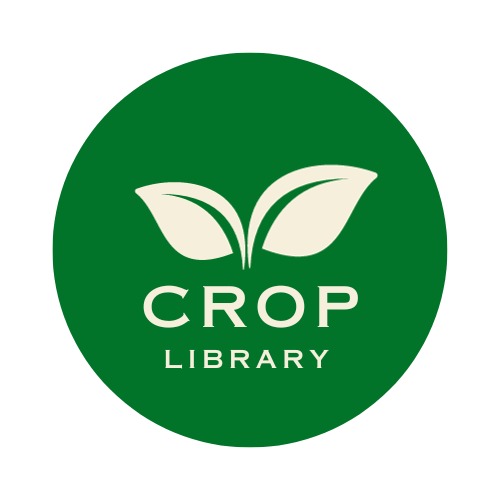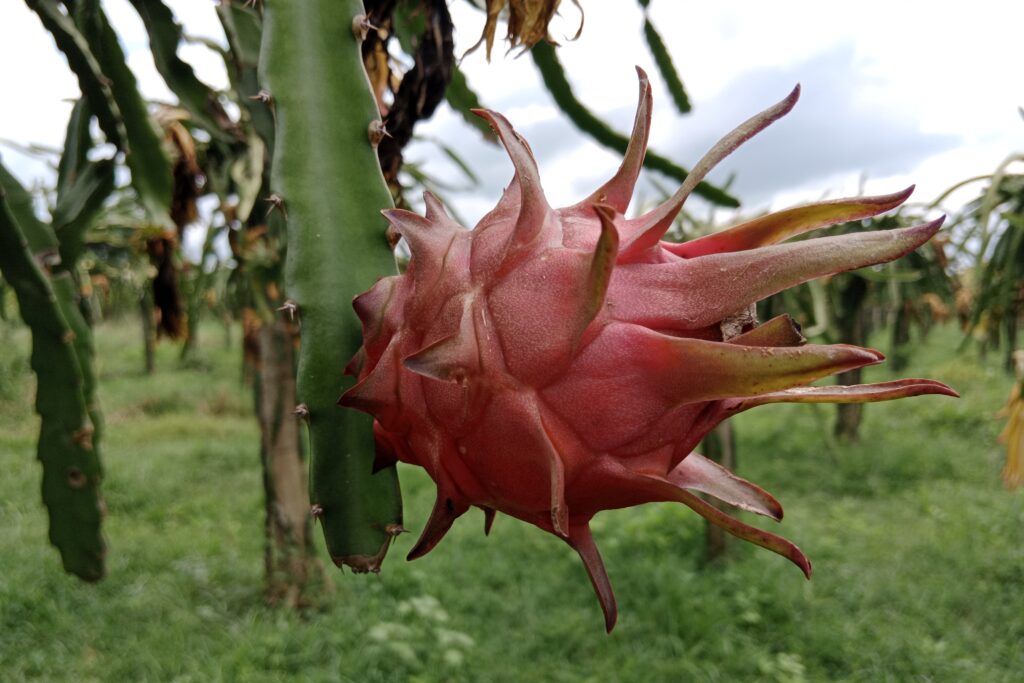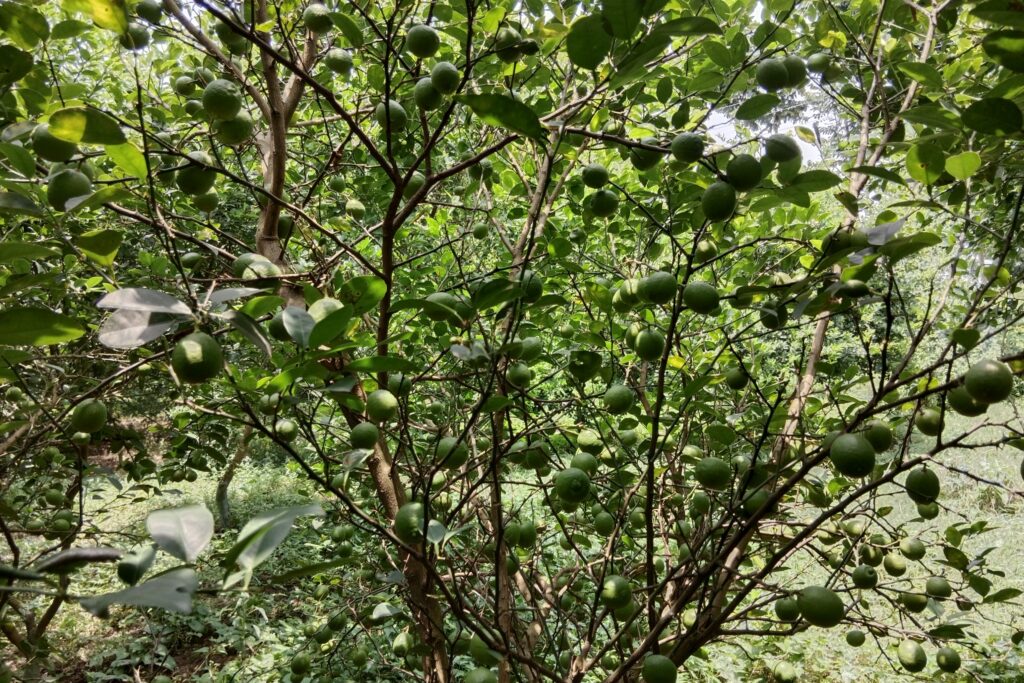Macadamia Nut Farming
A premium tree nut indigenous to Australia, macadamia nuts are prized for their excellent nutritious content and rich, buttery flavor. The macadamia tree, which grows in tropical and subtropical climates, yields spherical, hard-shelled nuts that are valued for their antioxidant, protein, and healthy fat content. Due to their high market value and extended productive lifespan, macadamia nuts—which are widely used in culinary and confectionary products—are also becoming more and more well-liked as a lucrative income crop.

Macadamia nut farming profit per acre offers an impressive long-term return, making it an attractive investment for growers. The break-even point is typically reached by Year 6, after which the farm becomes consistently profitable.
During the peak profit phase between Years 9 and 20, net annual earnings can reach around NRs. 2.62 million. Over a 40-year lifespan, the total investment—including an initial cost of NRs. 234,000 and maintenance expenses of NRs. 3.9 million—amounts to NRs. 4.13 million. In contrast, the total income from nut production is estimated at NRs. 74.57 million, resulting in a net profit of NRs. 70.44 million.
This translates to an average annual profit of NRs. 2.01 million from Year 6 onward. With a peak return on investment (ROI) of approximately 2,500% and a lifetime ROI of 1,605%, macadamia farming demonstrates exceptional profitability per acre over the long term.
Land Preparation
Successful macadamia orchard establishment begins with careful site selection, prioritizing well-drained slopes(ideally up to 15-20°) to avoid waterlogging and frost pockets, while avoiding heavy clay or shallow soils and ensuring good machinery access.
Clearingexisting vegetation, including trees, shrubs, stumps, and rocks, is essential, typically achieved through controlled burning or mechanical methods. Deep subsoiling or ripping (60-100 cm) along future tree rows is crucial next to break up compaction layers, significantly improving drainage and enabling deep root penetration.
On slopes, contouring or terracing must be established to minimize soil erosion and facilitate irrigation and general management. Finally, windbreaks (using species like Casuarina or Leucaena) should be planted before the macadamias, especially in exposed areas, to reduce damaging winds and lower evapotranspiration rates.
Soil Type
Macadamia trees thrive best in deep (at least 1 meter), well-drained, fertile loam or sandy loam soils with a slightly acidic to neutral pH range of 5.0 to 6.5; lime application is recommended if the pH falls below 5.0. Proper drainage is critical, as macadamias are highly sensitive to waterlogging and should not be planted in heavy clay soils or areas with high water tables. Additionally, soils rich in organic matter are advantageous for improving moisture retention and nutrient availability, supporting healthy tree growth and yield.
Climatic Requirements
Macadamia trees grow best in subtropical to mild temperate climates with optimal temperatures ranging from 15–25°C (59–77°F). While mature trees can withstand brief frosts down to -4°C (25°F), young trees are susceptible to damage below -2°C (28°F), and temperatures exceeding 35°C (95°F) can cause heat stress and sunburn.
Annual rainfall between 1200–2000 mm (47–79 inches), evenly distributed throughout the year, is ideal; however, dry spells during flowering and nut maturation can severely affect yields, making irrigation essential in areas with insufficient or irregular rainfall. Sites should be chosen to avoid frost-prone areas, particularly for young trees, and strong wind protection is crucial to minimize limb breakage and moisture loss, necessitating the use of windbreaks.
Major Cultivars
| Cultivar Name | Yield | Kernel Recovery | Nut Size | Flowering Type | Husk Spot Resistance | Key Characteristics | Pollination Needs |
| Beaumont | High | 38-40% | Large | Protandrous (♂ first) | Susceptible | Dominant variety, pink racemes, good precocity | Not specified |
| A4 | High | Excellent | Medium | Protogynous (♀ first) | Resistant | Very high kernel grade | Requires cross-pollination |
| A16 | High potential | 40%+ | Large | Protogynous (♀ first) | Resistant | – | Needs cross-pollination |
| A268 | High | Good | Very Large | Protandrous (♂ first) | Susceptible | Good precocity | Not specified |
| Kau | Reliable | Good | Smaller | – | Tolerant* | Hardy, older cultivar, tolerates suboptimal conditions/pests | Not specified |
| Selection 246 | Medium | Good | Smaller | – | Smaller tree size, often used as pollinator | Pollinator source |
Key Macadamia Species & Hybrids
| Variety Type | Nut Shape | Flavor Profile | Climate Adaptation | Notable Traits |
| Macadamia integrifolia | Rounder | Sweeter | Subtropical regions | Primary commercial species |
| Macadamia tetraphylla | Elongated | Slightly tangy | Cooler subtropical zones | Cold-tolerant |
| Hybrids (Integrifolia × Tetraphylla) | Variable | Combined traits | Broad adaptability | Blend desirable qualit |
Seedling rate per acre
Macadamia nuts are typically propagated vegetatively through grafting or budding onto suitable rootstocks to ensure true-to-type cultivars and promote earlier fruiting, usually within 3 to 5 years. For commercial planting, the recommended seedling rate is approximately 126 plants per acre.
Planting
a). Planting Season
Macadamia trees are ideally planted in autumn, during the cooler and wetter months, to reduce transplant shock and promote strong root development before the onset of summer heat. However, in frost-prone areas, planting is recommended in spring with careful attention to maintaining adequate soil moisture.
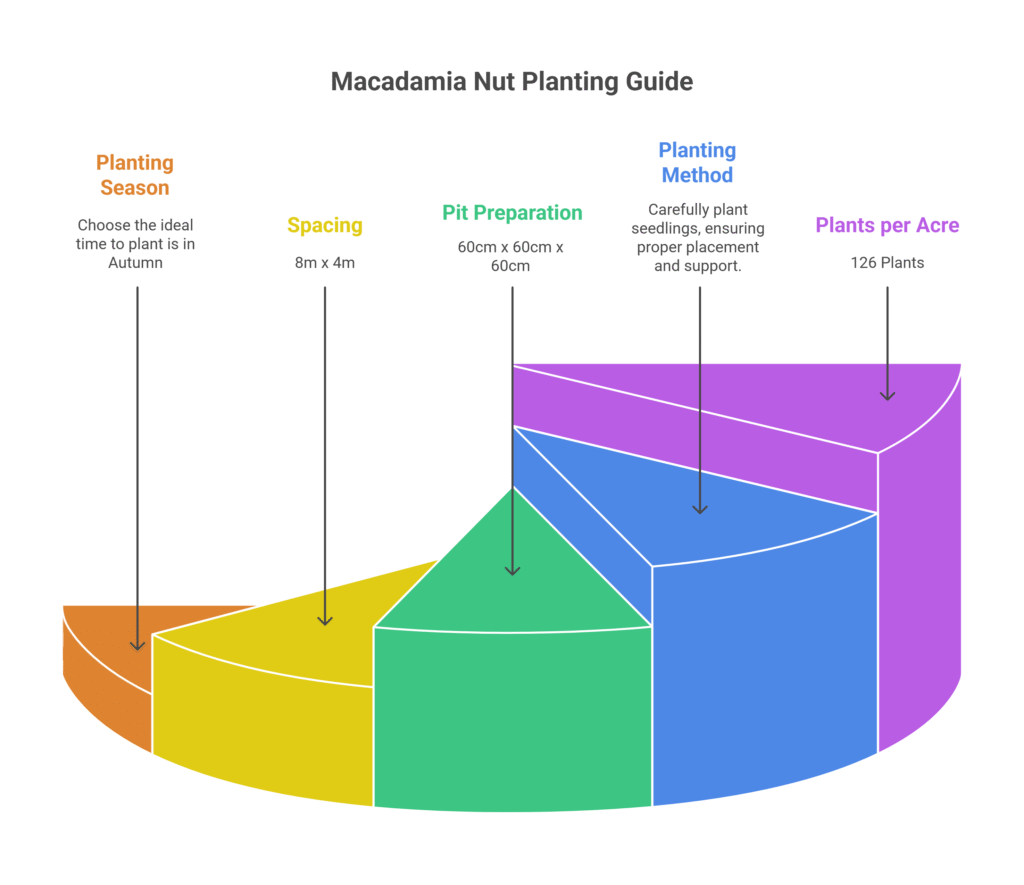
b). Spacing
The standard spacing for macadamia planting is typically 8 meters between rows and 4 meters between trees within a row, allowing adequate room for canopy development, sunlight penetration, and ease of orchard management.
c). Pit Preparation
Prepare planting pits of 60cm x 60cm x 60cm in length, 3-4 months before planting. Mix the excavated topsoil with 5–10 kg of well-rotted compost or manure, 200 g of a balanced basal fertilizer such as Single Super Phosphate, and 50 g each of Trichoderma viride and mycorrhiza. Refill the pit with the amended soil mixture and allow it to settle before planting.
d). Planting Method
When planting macadamia seedlings, begin by thoroughly watering them in their containers, then gently remove them to avoid disturbing the roots. Place the seedling at the center of the prepared pit, ensuring the graft union is positioned 5 to 10 cm above the final soil surface to prevent planting-related issues.
Backfill with the enriched soil mixture, pressing it lightly to remove air pockets. Immediately after planting, water the tree deeply and form a shallow basin around its base to retain moisture. In windy areas, loosely stake the tree for support, and apply a thick layer of mulch around the base, keeping it away from direct contact with the trunk.
e). Number of Plants per Acre
Based on the standard spacing of 8 meters by 4 meters, approximately 126 macadamia trees can be planted per acre.
Intercropping
In Macadamia orchards, intercropping is only practical for the first three to five years, when the tree canopy spreads out and covers the ground. It is best to avoid tall or deeply rooted crops like maize or sugarcane and instead plant low-growing, non-competitive plants like beans, peas, strawberries, ginger, turmeric, or medicinal herbs as intercrops.
Because legumes fix nitrogen, intercropping during this time can increase soil health, reduce weed growth, and generate early income. Intercrops must, however, not necessitate distinct irrigation or fertigation zones, compete substantially for water or nutrients, or act as hosts for pests or diseases that could harm macadamia trees. After the macadamia root system controls the soil profile, intercropping should be stopped.
Irrigation
Irrigation is crucial for macadamia trees during key stages such as the establishment phase (first 2–3 years), flowering in spring, nut development in summer, and nut filling in autumn. While mature trees can tolerate some drought, they perform significantly better with adequate watering.
Water requirements vary depending on climate, soil type, and tree age—young trees typically need 20–40 liters per tree per week, while mature trees may require 50–100 liters per week during peak summer. To ensure efficiency, drip irrigation is recommended as it delivers water directly to the root zone while minimizing evaporation and weed growth; micro-sprinklers are also used, but overhead sprinklers should be avoided due to the risk of promoting disease.
Irrigation scheduling should be guided by soil moisture monitoring tools like tensiometers or moisture probes, along with evapotranspiration (ET) data, aiming to maintain consistent moisture without waterlogging the soil.
Fertilizer and Manure
Initial Fertilization Approach
Refrain from applying fertilizer in the initial months after planting if proper soil preparation has been done. Start fertilization only after the trees exhibit new, fully hardened growth. Rely on detailed soil analysis to guide fertilizer use and avoid nutrient imbalances.
Application Timing & Method
Refrain from applying fertilizer in the initial months after planting if proper soil preparation has been done. Start fertilization only after the trees exhibit new, fully hardened growth. Rely on detailed soil analysis to guide fertilizer use and avoid nutrient imbalances.
Recommended Dosage & Composition
Use a balanced fertilizer with a 15:4:11 N:P:K ratio. Apply 50g per tree per application in years 1-2, increasing to 70g per tree in years 3-4. Supplement with lime or dolomite only if soil pH (tested in 1:5 water solution) falls below 5.0. Always adjust rates based on current soil tests.
Fertigation Preference
Where irrigation infrastructure exists, fertigation (delivering fertilizer through irrigation water) is the preferred method. This technique enables highly efficient, frequent small-dose applications directly to the active root zone.
Solid Fertilizer Application
When applying granular fertilizer, maintain a 20 cm clearance from the trunk to prevent burn. Distribute fertilizer evenly up to 30 cm beyond the leaf canopy. Water in immediately after application if irrigation is available. For slow-establishing trees, supplement with pelleted poultry manure alongside regular fertilizer.
Weed Control
Weed control is essential in macadamia orchards, particularly during the early years when young trees are highly vulnerable to competition for water and nutrients. Effective methods include mulching, mechanical control, and cautious use of herbicides.
Apply a wide (1–2-meter diameter), deep (5–10 cm) ring of organic mulch around each tree, keeping it away from the trunk, to suppress weeds, retain soil moisture, and regulate temperature. Mechanical control involves mowing between rows and hand weeding or shallow hoeing within the tree row or mulch area.
For chemical control, use herbicides carefully—pre-emergent herbicides can be applied under the canopy while avoiding contact with the trunk, and glyphosate (at a rate of 1–2% solution) may be used for spot treatment of weeds in the row middles. Always apply herbicides using shielded sprayers and strictly follow label instructions to avoid damage from drift onto green bark or foliage.
Interculture Operation
Training
During the early years of macadamia tree development (Years 1–4), training is essential to establish a strong and productive framework. Focus on developing a central leader structure with well-spaced primary scaffold branches that emerge at wide angles, ideally above 45°, as narrow-angled branches are structurally weak and prone to splitting under the weight of foliage or fruit.
Shaping the tree into an open vase or well-ventilated structure encourages better light penetration into the canopy, which promotes uniform growth, improves flower and fruit set, and reduces the risk of disease. Early and consistent training ensures easier long-term management and supports higher yields in mature trees.
Pruning (Mature Trees)
Pruning mature macadamia trees is critical for sustaining tree health, productivity, and field manageability. Begin by annually removing dead, diseased, or damaged (DDD) limbs to maintain orchard hygiene.
Manage the canopy by thinning excessive upright water shoots and eliminating crossing/rubbing branches to enhance light penetration and air circulation—boosting flowering, fruit set, and reducing disease risk. Control tree height (ideally below 6 meters) by tip-pruning or removing vigorous vertical leaders to ensure harvestability.
Additionally, practice “skirting” (cutting back low-hanging branches) to improve equipment access and ground maintenance. All pruning should occur after harvest, during late autumn or winter but before spring flowering, avoiding heavy cuts during active growth phases.
Flowering and Fruit Management
Flowering
Macadamia trees produce long racemes of flowers, up to 30 cm in length, typically appearing from February to April in the Northern Hemisphere. The small, fragrant flowers range in color from creamy white to pink and play a crucial role in nut development. Following pollination, macadamia nuts take about 6–7 months to mature, with natural nut drop occurring between March and September, depending on the region and cultivar.
Pollination
Pollination is primarily carried out by bees, with honeybees being especially important. Cross-pollination between compatible cultivars greatly improves nut set and overall yield. It is crucial to ensure that there are enough beehives present during the flowering period to maximize pollination.
Fruit Set and Drop
Although the initial fruit set is high, there is usually a significant natural drop of young nuts, often referred to as the “June drop”. The target fruit set after this drop is typically between 10% and 20%. However, severe stress factors such as drought, nutrient deficiencies—particularly boron—and pest infestations can cause excessive fruit drop.
Fruit Development
Once pollinated, the nuts require 6 to 8 months to fully mature. During this time, the outer husk, or pericarp, starts off green and fleshy but gradually hardens and splits open as the nut inside reaches maturity.
Pest and Disease Management
Common Pests
Nut Borer
The larvae of nut borer moths bore into young nuts, damaging the crop. Monitoring can be done using pheromone traps to track adult moth activity. Biological control methods, such as releasing Trichogramma wasps, can help reduce populations. When necessary, selective insecticides like Chlorantraniliprole at 60 ml per 20 liters of water or Emamectin benzoate at 5 g per 20 liters can be applied. Always follow local guidelines and apply during early larval stages for best results.
Stink Bugs
Stink bugs suck sap from developing nuts, leading to unsightly “sticker” defects that affect nut quality. Regular monitoring is important to detect infestations early. Border sprays with insecticides such as Bifenthrin at 20 ml per 20 liters or Lambda-cyhalothrin at 10 ml per 20 liters of water can help control populations. Encouraging natural enemies like predatory wasps also aids in management.
Fruit Spotting Bug
This pest causes gumming on nuts and can lead to nut abortion, severely impacting yields. Management strategies are similar to those used for stink bugs, including monitoring and timely insecticide applications. Use insecticides like Bifenthrin at 20 ml per 20 liters or Lambda-cyhalothrin at 10 ml per 20 liters of water, applied carefully according to label instructions.
Macadamia Twig Girdler
The larvae girdle twigs, causing dieback and weakening the tree structure. The best control is cultural: prune and destroy affected twigs promptly to prevent spread. Chemical control is generally not effective or recommended for this pest.
Rats and Birds
Rats and birds can cause significant nut losses, especially close to harvest. Control methods include baiting with rodenticides (such as bromadiolone-based baits) and trapping. Netting the orchard is an effective physical barrier to protect nuts from birds. Always handle rodenticides safely and follow local regulations.
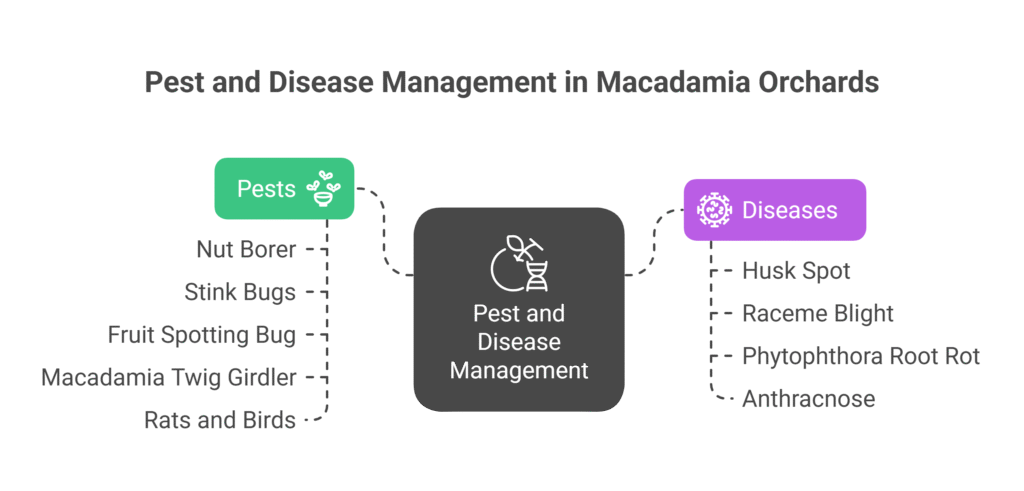
Common Diseases
Husk Spot
Husk spot disease causes black spots to develop on the husks of macadamia nuts, which can reduce the quality of the kernels inside. Managing this disease involves a combination of fungicide applications, planting resistant cultivars such as A4 and A16, and maintaining good orchard hygiene by removing fallen infected husks and debris.
For chemical control, apply fungicides like Copper oxychloride at 200-300 grams per 20 liters of water or Mancozeb at 20-30 grams per 20 liters. Sprays should be timed to protect the nuts during vulnerable stages, typically during nut development and before wet periods.
Raceme Blight
Raceme blight affects the flowers and young racemes, especially under wet weather conditions. This disease can significantly reduce flowering and nut set if not managed properly. Fungicide sprays are recommended during flowering when conditions are conducive to disease development. Use systemic fungicides such as Azoxystrobin at 15 ml per 20 liters or protectant fungicides like Mancozeb at 20-30 grams per 20 liters, applied early and repeated as necessary according to weather forecasts and label directions.
Phytophthora Root Rot
One of the most harmful diseases is phytophthora root rot, which is particularly prevalent in soils with inadequate drainage. The key is prevention; make sure the soil drains well and think about planting resistant rootstocks, such Hawaiian cultivars.
Fungicides based on phosphite are useful for chemical control. Every four to six weeks during rainy seasons, apply a foliar spray or soil drench containing 50 milliliters of potassium phosphite or phosphoric acid per 20 liters of water. Prevent waterlogging and enhance soil aeration to lower the prevalence of illness.
Anthracnose
Anthracnose affects both the husks and leaves of macadamia trees, causing lesions that can weaken the tree and reduce yield. Control measures include regular fungicide applications and good orchard sanitation by removing infected plant material. Recommended fungicides include Copper oxychloride at 200-300 grams per 20 liters or Mancozeb at 20-30 grams per 20 liters, applied preventively during periods of high humidity or rainfall. Consistent spray programs and cultural controls help keep this disease in check.
Harvesting
Timing
Macadamia nuts take several months to mature. The harvest season normally lasts from September to December in the Northern Hemisphere and from March to June in the Southern Hemisphere. When the husk cracks open, the naturally matured nuts fall to the ground. Premature harvesting can seriously impair nut quality, so it’s crucial to only collect fallen nuts and refrain from shaking the trees or picking nuts before they are completely developed.
Frequency
Harvesting is carried out in multiple rounds, generally every 2 to 4 weeks throughout the entire nut drop period. Typically, this involves about 6 to 8 harvest rounds each season. Prompt and regular collection of fallen nuts is crucial to prevent losses due to mold growth, fermentation, and pest damage, all of which can occur if nuts remain on the orchard floor for too long.
Method
The majority of the harvesting is done by hand, with nuts being picked straight from the ground. It is crucial to keep orchard floors smooth and clean in order to make gathering simple and shield the nuts from harm. In order to increase productivity and save labor expenses, mechanical harvesting tools like sweepers and vacuum harvesters are being utilized more and more in bigger commercial orchards.
Husk Removal (Dehusking)
After harvesting, it is critical to remove the outer husk (dehusking) within 24 hours to avoid heat buildup inside the nuts, which can lead to quality deterioration. This process is usually performed mechanically at the farm shed or processing facility. Timely dehusking helps maintain nut quality and prepares them for subsequent drying and processing steps.
Yield
Trees typically begin producing small crops between 3 to 5 years of age, with economic yields usually starting around 6 to 8 years. Peak production is generally reached at 12 to 15 years, and well-maintained orchards can remain productive for over 40 years.
In terms of quantity, younger trees (5-7 years) yield about 1 to 3 kg of in-shell nuts per tree, increasing to 5 to 15 kg per tree at 8 to 10 years. Mature trees growing under good conditions can produce between 25 to 50 kg per tree.
On a larger scale, per acre yields range from roughly 400 to 1,000 kg at year 10, and mature orchards commonly produce between 1,400 and 1,800 kg per acre. Kernel recovery typically accounts for 30-40% of the in-shell nut weight, meaning that 1,000 kg of in-shell nuts would yield about 300 to 400 kg of kernel.
Cost of Investment per acre for Macadamia Farming
Initial Investment Cost (Year 1)
| S.N. | Categories | Cost (NRs.) |
| 1 | Land Preparation (plowing) | 15,000 |
| 2 | Plant saplings (126 units) | 40,000 |
| 3 | Pit digging | 10,000 |
| 4 | Planting | 7,000 |
| 5 | Fertilizers and Manure | 35,000 |
| 6 | Irrigation (Drip) | 100,000 |
| 7 | Weed Control | 7,000 |
| 8 | Pest & Disease Control | 10,000 |
| 9 | Miscellaneous Costs | 10,000 |
| Total Initial Investment | 234,000 |
Annual maintenance cost per acre for Macadamia Farming
From the second year onwards, the annual maintenance cost for macadamia farming is estimated at around NRs. 100,000 per acre. This recurring expense includes key operational activities such as labor for pruning, weeding, and harvesting; application of fertilizers and organic manure to support healthy tree growth; regular irrigation (often through drip systems); and effective pest and disease management.
Additionally, it covers miscellaneous upkeep necessary to maintain orchard hygiene and ensure consistent flowering, fruit set, and high-quality nut production throughout the productive life of the plantation.
Income from per acre macadamia farming
| Year(s) | Yield (kg/acre) | Price (NRs./kg) | Income (NRs.) |
| 4th Year | 45 | 1,500 | 67,500 |
| 5th Year | 227 | 1,500 | 340,500 |
| 6th Year | 454 | 1,500 | 681,000 |
| 7th Year | 907 | 1,500 | 1,360,500 |
| 8th Year | 1,361 | 1,500 | 2,041,500 |
| 9th–20th Year | 1,814 | 1,500 | 2,721,000/year |
| 21st–30th Year | 1,588 | 1,500 | 2,382,000/year |
| 31st–40th Year | 907 | 1,500 | 1,360,500/year |
Analysis of Macadamia Farming Profit Per Acre
| Year | Cash Outflow (NRs.) | Cash Inflow (NRs.) | Net Cash Flow (NRs.) | Cumulative Cash Flow (NRs.) |
| Year 1 | 234,000 | 0 | -234,000 | -234,000 |
| Year 2 | 100,000 | 0 | -100,000 | -334,000 |
| Year 3 | 100,000 | 0 | -100,000 | -434,000 |
| Year 4 | 100,000 | 67,500 | -32,500 | -466,500 |
| Year 5 | 100,000 | 340,500 | 240,500 | -226,000 |
| Year 6 | 100,000 | 681,000 | 581,000 | +355,000 |
| Year 7 | 100,000 | 1,360,500 | 1,260,500 | 1,615,500 |
| Year 8 | 100,000 | 2,041,500 | 1,941,500 | 3,557,000 |
| Years 9–20 | 1.2M/year (12 yrs) | 32.65M (12 yrs) | 31.45M | ~35.0M |
| Years 21–30 | 1.0M/year (10 yrs) | 23.82M (10 yrs) | 22.82M | ~57.8M |
| Years 31–40 | 1.0M/year (10 yrs) | 13.61M (10 yrs) | 12.61M | ~70.4M |
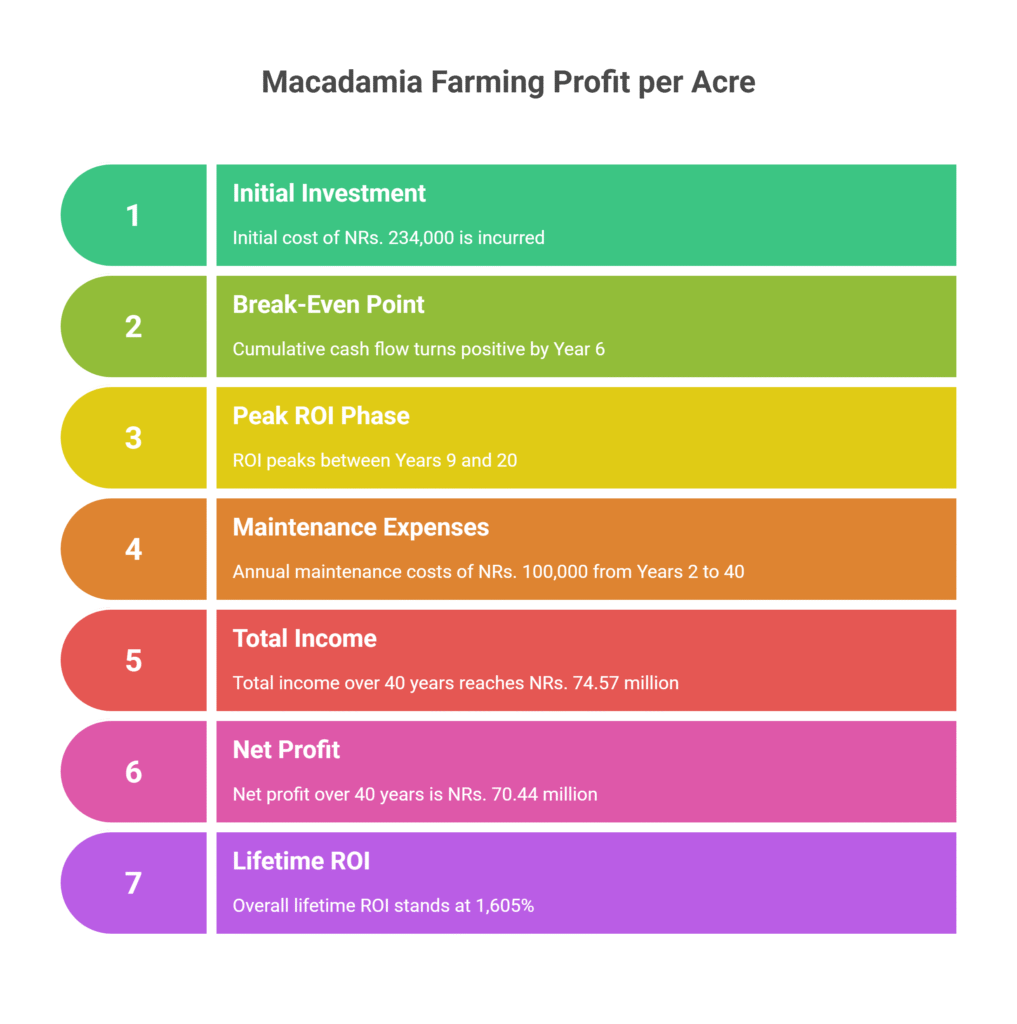
The break-even point in macadamia farming is typically achieved by Year 6, when cumulative cash flow turns positive. The peak return on investment (ROI) phase occurs between Years 9 and 20, generating an average net annual profit of approximately NRs. 2.62 million.
Over the 40-year lifespan, the total investment includes an initial cost of NRs. 234,000 and maintenance expenses of NRs. 3.9 million (NRs. 100,000 annually from Years 2 to 40), bringing total costs to NRs. 4.13 million. Meanwhile, the total income over this period amounts to NRs. 74.57 million, resulting in a net profit of NRs. 70.44 million.
This translates to an average annual profit of NRs. 2.01 million from Years 6 to 40. The ROI during peak years reaches approximately 2,500%, while the overall lifetime ROI stands at 1,605%, making macadamia farming a highly profitable long-term investment.
Sources
Food and Agriculture Organization (FAO)
University of California Agriculture & Natural Resources (UC ANR)
Punjab Agricultural University (PAU)
Tamil Nadu Agriculture University (TNAU) – Agritech portal
Indian Council of Agricultural Research (ICAR)
Nepal Agricultural Research Council (NARC)
